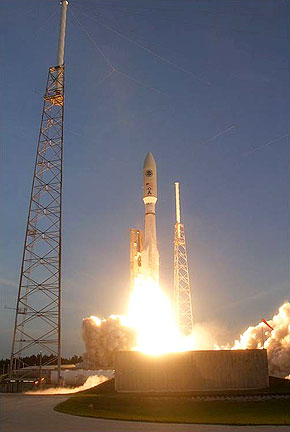
A United Launch Alliance Atlas V Rocket with the Air Force's Advanced Extremely High Frequency - 1 (AEHF-1) satellite launches from the Space Launch Complex-41 launch pad at 7:07 a.m. EDT, Aug. 14, 2010. The AEHF constellation of satellites will provide 10 times greater capacity and channel data rates 6 times higher than that of the existing Milstar II communications satellites. (Photo by Ben Cooper, Space Flight Now)
As of this writing, AEHF-1 has crossed the 20,000 km. perigee mark. Orbit-raising for AEHF-1 is successfully continuing as planned, according to Dave Madden, director of the Military Satellite Communications Systems Directorate. Shortly after the launch Aug. 14, 2010, the orbit-raising plan was modified as a result of an anomaly with the bi-propellant propulsion system, which was intended to place the spacecraft near its operational orbit. The new plan entails two phases: one phase using hydrazine thrusters, which is now complete; the other using AEHF's Hall Current Thruster electric propulsion system. The HCT electric propulsion system has achieved more than 2,100 hours of successful operation.
The satellite is safe, continues to operate as planned and is expected to reach geosynchronous orbit in late summer 2011. "Throughout the anomaly recovery, re-planning, and orbit-raising operations, a government and contractor team has demonstrated incredible technical expertise and innovation to work around the anomaly and create the opportunity to achieve mission success for this critical national asset," said Madden. Upon reaching its planned orbit, AEHF-1 will provide a significant enhancement to our nation's survivable communications infrastructure by allowing operators to communicate in a wide range of environmental conditions. AEHF will provide tactical and strategic satellite communications to Army, Navy, Air Force and Marine users, as well as a host of other agencies. AEHF will extend the capabilities of the operational Milstar satellite constellation with an order of magnitude increase in protected communications capability. AEHF is developed by the MILSATCOM Systems Directorate, which develops, acquires and sustains space-based global communications in support of the President, Secretary of Defense and combat forces. The MILSATCOM enterprise consists of satellites, terminals and control stations and provides communications for over 16,000 air, land and sea platforms.

